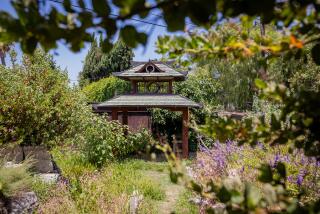Gardening : Cacti Solve Prickly Water Problem
- Share via
The cactus has been stuck with a bad reputation ever since settlers first set foot onto Western soil--and into the pointy needles of the spiny plant. But early ranchers wasted no time in finding practical uses for them: the “prickly pear” cactus was commonly used to fence in animals (or to keep trespassers out); some types are edible, and in times of desperation, a cactus can even be a source of water.
As Southern California faces yet another water crisis, gardeners looking for ways to conserve water may not have to look any further than their own back yards. Cacti and succulents can add symmetry, texture and color to a landscape--and all the while conserve water during the dry summer months because of their ability to store water.
But drought tolerance is just one appealing quality, says Larry Grammer, who grows more than 800 cacti and succulents in his greenhouse and outside of his Long Beach home.
Baja the Turning Point
A trip to Baja California in the ‘70s influenced Grammer’s choice of plants. The Texaco oil refinery worker was a house-plant and yard man up to that point, but his introduction to the cactus in Mexico had a lasting impact.
“I was camped in the middle of them and looking at their spines, formations and the geometric-type patterns--the way they clumped and criss-crossed,” he recalls. “That one trip changed my mind, and they weren’t even in flower.”
But it’s typically a cactus in bloom that makes a cactus convert, says John Trager, curator of the desert collection at Huntington Botanic Gardens (one of the largest and most diverse collections in the world, with more than 5,000 species). “What usually appeals to people is the brightly colored flowers coming out of these unusual plant forms--they’re beautiful,” Trager says.
Cacti can be grown indoors and out; they range in size from tiny button-size (from Argentina) to hulking 300-pounders (the Huntington has samples of these).
Get a good look at more than 1,000 cacti and succulents at the fourth Inner-City Cactus & Succulent Show and Sale going on at the L.A. Arboretum today and Sunday. “The public will see things at the show that are magnificently grown,” Trager says. “They’ll see the results of good care.”
Pooling Resources
Grammer is show chairman for the Long Beach Cactus & Succulent Club, one of three clubs pooling resources to put on the show. Though he grows his plants partially for the enjoyment and relaxation, a competitive streak surfaces at show time, as he enters his own prize plants in the show.
“I feel good about the show,” Grammer says. “The show is there to educate the public, but it’s also nice to show off your hobby.”
Trager says two of the most common mistakes gardeners make is overwatering a cactus and assuming it will take care of itself. “The No. 1 problem is a lack of fertilizer,” he says.
Grammer uses a porous mixture of pumice, a “little bit” of sand and potting mix to grow show-quality cactus. “I water once a week in summer (the growing period) and I stop watering in November and let them rest till March 1,” he says.
This might surprise some gardeners, but the cactus’ ability to survive without water is one of the qualities that makes it so practical for the Southern California climate.
Overwatering Can Kill
“Watering too much at the wrong time of the year can really hurt,” Grammer says. “They withstand the cold better when dry.” If the roots are wet and the weather turns cold, it “will kill them,” he says.
Some of the plants to look for at the show include agaves and aloes, both succulents, the golden barrel cactus and cereus cactus.
“These grow very well in almost any garden situation,” Trager says, “as long as they’re not overwatered. They certainly provide unusual and different design potential . . . mixing in well with other garden plants.”
Los Angeles State and County Arboretum, 301 N. Baldwin Ave., Arcadia. Information: (818) 446-8251. Arboretum admission: $3; seniors 62 and older and students with ID, $1.50; children under 12, 75 cents. Hours: 9 a.m.-5 p.m.






